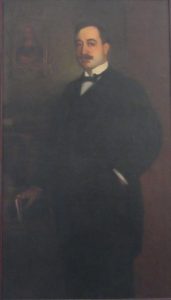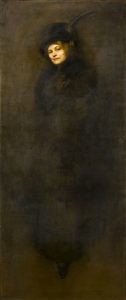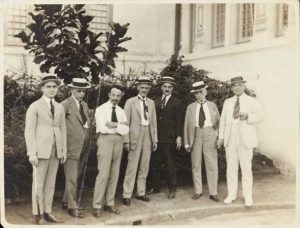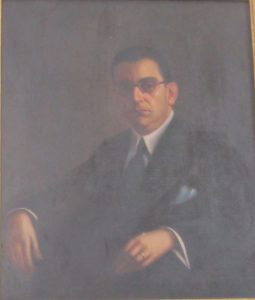Sílvia Lanceta and Juli G. Pausas
In this article we continue to discover the figure of the Catalan Modernist painter Francesc Pausas i Coll, discreetly recognised, and who we started to get to know in the article Maria Sampere and Francesc Pausas in the Museu Nacional d’Art de Catalunya a few months ago.
Last time we left him living and working in New York City. Now we will follow him until Havana, a city where he received plenty of commissions and where he moved with his family at the beginning of the 1920s.
Pausas in Havana
The first painting that links Pausas with Cuba is the Portrait of Orestes Ferrara, painted in New York in 1914. Orestes Ferrara, lawyer, journalist and influential politician in Cuban public life, was a great admirer of Francesc Pausas i Coll. Currently, the portrait of Ferrara can be found in the entrance of the Museo Napoleónico de La Habana, the old Ferrara palace; the only painting, as far as we know, which is publicly exhibited on the Antilles island. Next to the portrait, on the sign that indicates the authorship, you can read «F.Paiyas». We notified them of the mistake (July 2019) in the hope that it might be amended.

Portrait of Orestes Ferrara, Francesc Pausas, 1914
A prolific decade in the painting by Pausas (1919-1929)
In 1917, still in New York, Pausas painted a portrait of the secretary of the Cuban state, Aurelio Hevia. However, it was Josep Marimon i Juliach, president of the Banco Español on the island of Cuba who, impressed by the prestige of Pausas in the United States and the quality of his oil paintings, who would invite him to Havana.
At the end of 1918, Pausas travelled to Cuba for the first time, where he painted portraits of notable characters from the political and business world. He would soon become a well-known painter and received so many commissions that he returned the following winter.
We don’t know in which year exactly Pausas-Sampere couple moved definitively to Havana, but for sure it was at the beginning of the 1920s. We could say that it was no later than 1923, if we take into account the letters that his friend Ramon Vilaró sent to him when he was already in this city; and the newspaper Anaïs Nin, in which the writer, dated 18th June 1924, recalled that Maria Sampere had sold the furniture (we suppose of the New York home to go and live in Havana).
Right from the outset, Pausas got involved in the life of the city, specifically the cultural and artistic life; he became a member of the Association of painters and sculptors of Havana, and participated in the Fine Arts Trade Fairs of 1921, 1922 and 1928.
In August 1922, Pausas painted some decorative paintings for one of the rooms of the Casino of the beach of Marianao, where he had set up his studio, and where he continued to do portraits. Unfortunately, the Casino no longer exists, and therefore we cannot contemplate the paintings that decorated it.
Pausas’ exhibition in the convent of Santa Catalina
In March 1920, Pausas decorated the retroquire of the old convent of Santa Catalina, which no longer exists, and exhibited forty-seven paintings. Among these, it is worth highlighting some of the ones that appear cited as being the most important in the Dictionary of plastic artists of Cuba (A. Rodríguez Morey, 2013): Spring (portrait of Nena Conangla Tomás); My father-in-law (José Sampere); Portrait of the Lady of Marimón (Caridad Salas), Portrait of José Marimón, María Gay in Carmen, Portrait of Dr Julio de la Torre, My wife, Self-portrait, Portrait of Coronel Hevia, My mother (Leonor Coll), Dusk, Cabo de Creus, Lolita, Portrait of the Lady of Ferrara (Ma. Luisa Sánchez), Portrait of Mr. Bonet, Portrait of Ms Duque and Apasionatta.
Eight thousand catalogues of the exhibition were published, many of the paintings were sold and the Cuban press covered it very well. «The success of the Pausas exhibition has surpassed all the concepts of the other artistic exhibitions held in Havana. And this affirmation is justified by all the newspapers and magazines, with a unanimous criteria in which enthusiastic praise was made of the art of our excellent painter, one of the most outstanding to have passed through Havana, and undoubtedly the best regarding the difficult genre of portrait painting.» This is how La Nova Catalunya began its report in March 1920 dedicated to the exhibition; and then continued with a summary of the comments made in other Cuban newspapers: Heraldo de Cuba, Diario de la Marina, La Prensa, La Noche, El Mundo, etc.
Maria Sampere
My wife (the portrait of Maria Sampere i Montseny), currently exhibited in the room of the bourgeois portrait of the Museu Nacional d’Art de Catalunya, which we referred to in the previous article, was also exhibited in the convent of Santa Catalina. It is the second time, as far as we know, that this portrait of 1911 has been exhibited in public. «In the portrait of his wife, who appears dressed in a suit and black hat and that stands out on a neutral background, Pausas has resolved a difficult problem of technique. This portrait is truly wonderful. » (Bohemia, 21st March 1920). The Cuban magazine described in minute detail the other portraits of the exhibition.

Portrait of Maria Sampere, the Painter’s Wife, Francesc Pausas i Coll, 1911
The portrait of Maria Sampere was also highlighted in the Vida Catalana, Nº. 211 (Havana May 1920): «Among these portraits and those that have only wanted to do art par excellence, there is a notable selection that affirm the celebrity to be enjoyed [SIC]. The one labelled “My wife” for example, you just need not pay a fabulous amount to have a reminder of a Rembrandt, that he will not see while still alive, nor did the immortal Dutch master enjoy such satisfaction».
Pausas and the Catalan Centre of Havana
Obviously, he connected with the Catalan Centre of Havana and the activities organized there. In 1924, Pausas was commissioned, along with the painter Garcia Escarré and the furniture maker Anton Agramunt, with the artistic decoration of the new headquarters of the Centre, in the old Montalvo palace. That same year, the Centre would celebrate a banquet in homage to Pausas, in the Jardines de la Tropical.

Members of the Catalan Center of Havana, at La Playa de Marianao casino (Havana). From left to right: Josep Pineda i Fargas, Francesc Molla i Presas, Francesc Pausas i Coll, Josep Conangla i Fontanilles, Pere Pons Cercós, Claudi Mimó i Caba, and Joaquim Muntal i Gramunt [Source: La Nova Catalunya, n. 254, August 1922]
Pausas kept up a very close relation with the Catalans of Havana, especially with Josep Conangla i Fontanilles (Montblanc, 1875 – Havana, 1965) a notable journalist, one of the founders of La Nova Catalunya and writer of the provisional Constitution of the Catalan Republic. And he painted the portraits of Francesc Molla, former president of the Catalan Centre (1922) and of Eudald Romagosa, president of honour of the Societat de Beneficència de Naturals de Catalunya. The Portrait of Mr. Romagosa (1928) can currently be found in one of the offices of the current headquarters of the Societat de Beneficència de Naturals de Catalunya.

Portrait of Eudald Romagona, Francesc Pausas, 1928
The archive conserves, among other documents and publications, La Nova Catalunya. This magazine, notably political, allows us to delve into a time and space in which Pausas lived. A cosmopolitan Pausas, like the art he admired and longed to achieve. This may help us to understand one of the silences we talked about in the article about Maria Sampere and Francesc Pausas in the Museu Nacional d’Art de Catalunya.
One hundred years later
There are innumerable paintings that Pausas did in Cuba. We do not know where they may be now, because a lot has happened since then, even a revolution. But we will continue to investigate to find out which walls all these paintings are hanging on nowadays, and especially Carnaval, a large-sized composition in which three girls in fancy dress appear: one as a Harlequin, another as a Chinese girl, and the third as a bullfighter, sitting in the foreground on a Manila shawl.

Carnival, by Francesc Pausas. Unknown location
In 1947, Maria Sampere gave Carnaval as a gift to her friend Conangla. According to his descendants, the painting remained on the island, when the family Conangla left it at the end of the 1960s. If anyone who reads this knows where Carnaval ended up, we will be eternally grateful if you could let us know.
One hundred years later, finding testimonial remains of Francesc Pausas’ time in Havana – a prolific decade in his artistic career – has been quite a challenge, because History often erases the History that precedes it. And maybe for this reason, it explains another silence.
Related links
Francesc Pausas Coll (1877-1944), universal and unknown painter
Maria Sampere and Francesc Pausas in the Museu Nacional d’Art de Catalunya
Francesc Pausas in the online collection of the museum
Sílvia Lanceta and Juli G. Pausas







